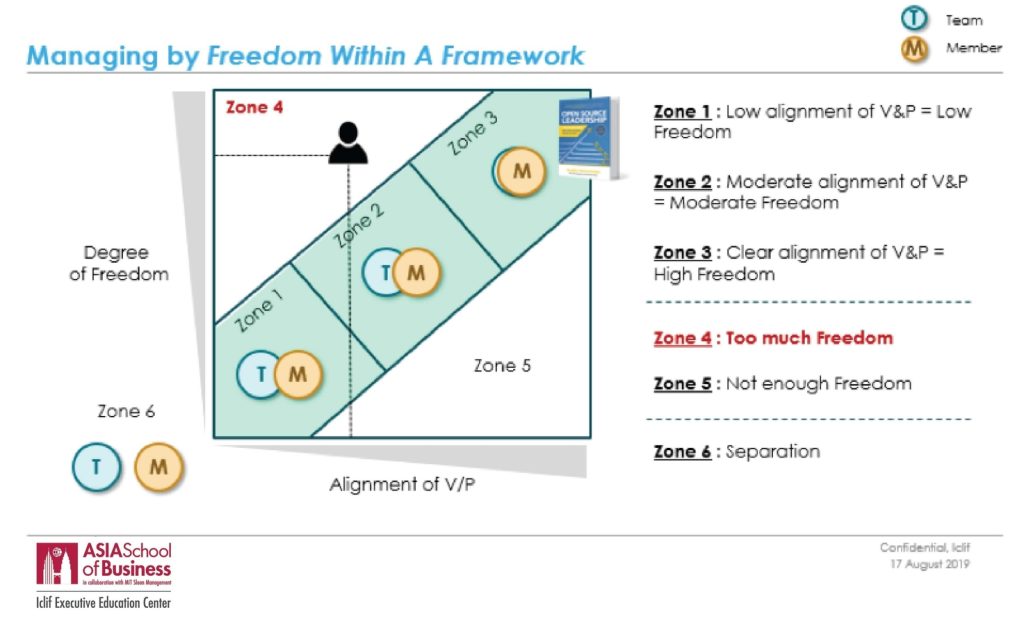“Dr Tan, I’m really fascinated by the Freedom Within A Framework idea.” Olivia, a manager who recently attended our Iclif program shared with me. We were having a follow-up reflection conversation.
“But the problem is, I don’t know how to put it into practice.” She continued: “I manage 15 people. I can’t just give everyone freedom to roam – the risk is just too high.”
“Would you like me to show you something to see if it helps?” I asked. The manager nodded enthusiastically. I gave Olivia one yellow Post-It note and asked her to think of a subordinate from her team. I then asked her to write down her best guess of the person’s Values & Purpose. The concept of Leadership Energy was discussed at length during the program she attended, so Olivia knew exactly what I meant.
It took her about 10 minutes to come up with 1) Harmony 2) Integrity 3) Security 4) Family and 5) Accuracy, as the Values. For Purpose, she wrote, ‘To be a good father and a responsible worker’.
On another piece of Post-It note – a blue one – I asked Olivia to think of the Values and Purpose she would like to see in her team. This time she quickly wrote 1) Integrity 2) Results 3) Excellence 4) Customer-Centric and 5) Teamwork. Her team’s purpose was ‘To become the number one branch in the region’.
“Good. Now, please overlay the two pieces of the notes,” I told her. “You can decide how much they overlap – ranging from a small area to a complete coverage.” Olivia looked at the information on the two notes. She decided they were about 40% overlapped; particularly around Integrity and Harmony/Teamwork. “Last question, what is the degree of freedom have you been giving him?” She thought about it for a minute then said probably about an 8 out of 10.
“I’m not a micromanager. I like to give my people freedom,” Olivia smiled sheepishly. I drew a diagram like the picture below in front of her. One axis is labeled Alignment of Values/Purpose and the other is labeled Freedom. I explained briefly what each zone means in the context of Freedom Within A Framework.

We placed on the chart the coordinate this manager has assigned her subordinate: 4 for alignment of Values and Purpose and 8 for Freedom. “And there is your problem,” I told her. “You have been giving him too much freedom.” The coordinate placed us in Zone 4: Too much Freedom. This zone describes a mismatch between Low Alignment of V&P and High degree of Freedom.
In laymen’s terms, this means the person has not earned the right to be completely trusted by his manager. In Olivia’s case, this is because the subordinate has not shown – at least to the boss’s eyes— his sharing of the team’s Values for Results, Excellence, and Customer-Centric.
If given a lot of freedom, he could make decisions that violate the team’s Values. For example, he could choose to attend his daughter’s recital and not submitting his work on time. “So, I can’t give him the freedom?” She frowned. “Well, no and yes.” I smiled and shared with her the following points.
Alignment of V&P is proportional to Freedom. The more your people show that they will act according to your team’s Values and Purpose, the more you can trust them to do the right thing. Mary Barra, the current CEO of General Motors, said this amidst her difficult decision to recall over 1-million GM cars due to manufacturing defects: “We quickly defined our guiding principles based on our values…
If the company sees you do the right thing, and your people know you are going to do the right thing even when it’s hard. That, to me, is so important for me to trust that we are doing the right thing at all levels, every day.” (Power Moves: Lessons from Davos (2018) by Adam Grant) Therefore, as a leader, you should aim to maximize your team members alignment of V&P. Achieving this starts with 1) to define clearly and communicate what your team’s V&P are; and 2) to observe and understand each of your team members’ V&P.
In Olivia’s case, her team member needs to learn that while it is okay to value Family, he must also respect the other important values of the team, e.g. Results and Customer-Centric, as well. This means that even if he chose to attend a family event, he must also deliver work on time and excellently. Olivia may need to have a conversation and move him to Zone 2, i.e. lower freedom, until she sees the behavioral alignment.
Give freedom to those who have earned it. Shape those who haven’t. Interestingly, many managers I have interacted with say that they have a great team; with members clearly aligned with the team’s V&P. In fact, ‘Alignment to Organisation Culture’ had the highest score in one of Iclif’s 360-degree Leadership Readiness Surveys of a 30,000-employee organization. Yet, these team members are managed with a lot of rules and policies, i.e. no freedom. The combination of a high degree of alignment but a low degree of freedom is described in Zone 5: Not enough freedom, which leads to unnecessary delays, frustrations, and distrust.
In Iclif’s most recent book, Open Source Leadership (2017), the author Rajeev Peshawaria highlights the fact that in today’s business environment, speed is everything and the ability to remain agile and nimble in an ever-changing landscape is critical. Unfortunately, many of today’s organizations still operate as if it were 1990 by not trusting their employees and imposing strict internal rules, policies, processes, and procedures. The result is a bureaucracy which is anything but agile and nimble. Organizations and leaders should relook at how they are managing their people by Freedom Within A Framework and adapt their approach, especially if they have earned it.
Be careful not to give Freedom simply based on performance. V&P alignment and performance may not necessarily go together. Don’t make the mistake that some managers do by simply giving employee freedom based on performance. This may breed a toxic culture because there is a right and wrong way of delivering results. Instead, the organization should always act in accordance with their Values & Purpose, even if it means reprimanding their top business performers.
In his book The No Asshole Rule: Building a Civilized Workplace and Surviving One That Isn’t (2007), a Stanford University professor Robert I. Sutton wrote about a case at a company called The Men’s Warehouse. It fired a selfish and difficult employee even though he was one of the company’s most successful salespeople, and as a result, the total sale volume in the store increased. Another example cited was a fortune 500 company where the CEO fired people who acted against the organizational Values. According to Sutton, the firm benefited from firing these Zone 6: Separation employees and had risen to become one of the top firms in the industry.
What may be counterintuitive is that even those who may be perceived as a ‘low performer’ can also be given freedom if they had proven themselves to act in alignment with the team’s Values & Purpose. In another chapter of Open Source Leadership (2017), Rajeev shares a view that to give everyone in the organization a ‘stretch’ goal is unproductive. The manager should instead have an honest conversation about expectations.
For example, the employees should be allowed to choose the lower end of the bell curve if they agree that a lower performance is fairly linked to lower remuneration. This is a perfect example of Managing by Freedom Within A Framework – the parties are aligned on their values & purpose, leading to working with a high degree of freedom, i.e. Zone 3.
“Wow, thank you Dr Tan. This is very helpful!” Olivia exclaimed. “The chart really helps me to see the relationship between Values & Purpose and Freedom. I can already begin to see where some of my people sit in the different zones, and how I should support them to move towards earned Freedom.”
Here’s a recap of what Olivia and I did together:
- Think of 1 member in your team, e.g. reportee, colleague, or even boss
- Decode her/his Values & Purpose; write them down on a Post-It note
- Pick another Post-It note, write down the team’s/organization’s Values & Purpose
- Decide how much the two notes overlap – place them accordingly
- Assign the current degree of Freedom and map onto the chart
- Examine the corresponding Managing by Freedom Within A Framework Zone
- Think about how you can improve / optimize the current situation
- Have a discussion with the person to manage the current status while developing the relationship towards Zone 3
What do you think?
Try Managing by Freedom Within A Framework with your team and do let us know how it works out!

Dr Thun Thamrongnawasawat (Tan) is one of the foremost experts on dissecting complex management and business models and cascading them for easy implementation by companies across different industries. His innovative B.A.S.E. model has inspired numerous organizations to transform. He’s the author of the Brain-BASEd Leadership book series (2013-2016), a bestselling The Leadership Journey (2018) and a regular newspaper columnist. In 2015, Dr Thun was the recipient of World HRD Congress’s “Global Coaching Leadership Award” and named “Consultant of the Year” by the Ministry of Industry, Thailand.
He can be contacted at thun@asb.edu.my.
If you are interested to know more about our exciting Executive Education program click here.





